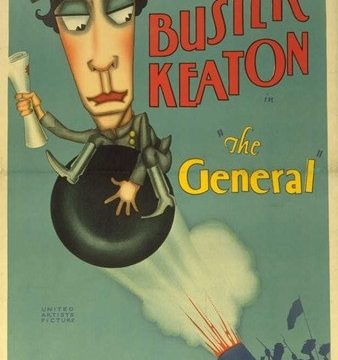Sight & Sound Voyage Entry #32
Placement On Sight & Sound Top 50 Movies List: #34
Me and my love for classic silent movies have already had plenty of experiences with one Mr. Charlie Chaplin while the phenomenal motion picture Safety Last! allowed me the chance to be introduced to Harold Lloyd, another titan of this era of filmmaking. But despite my intense affection for this particular decade of movies, there’s one major star from the age of classic silent movies that I have not been exposed to; the one and only Buster Keaton! Yep, somehow Keaton and his numerous massively influential features have passed me by over the year, though that changed for the better recently when I finally saw Keaton’s 1926 feature The General!
This particular Buster Keaton film is set during the Civil War, with an engineer by the name of Johnnie Gray (Buster Keaton) who attempts to enlist in the Confederacy army, but is rejected by higher-ups who believe he will be more valuable to them as an engineer. This creates an enermous rift between the distraught Johnnie Gray and his girlfriend, Annabelle Lee (Marion Mack), who had previously said she didn’t want to see her beloved engineer again unless he himself was wearing an army uniform. The two part ways after that, leaving Johnnie Gray further emotionally devastated.
But don’t worry, Johnnie will get his chance to participate on the battlefield as he gets embroiled in the combat itself after some Union soldiers overtake a Confederate train. While trying to stop them, he becomes embroiled in the battle itself since he discovers Annabelle Lee has been kidnapped and he’s not about to let her remain a hostage! A classical romantic tale set amidst more stylized and/or larger-in-scale circumstances (a common storytelling vessel in the era of classic silent movies) ensues, one that has all the hallmarks of both a great silent comedy and a transfixing romantic tale set in the 19th century.
Buster Keaton, in comparison to other silent movie titans like Harold Lloyd and Charlie Chaplin, seems more restrained in terms of hand gestures or facial expressions but he’s still got the kind of knack for handling over-the-top material that made you an absolute star back in this epoch. He fully commits to this part of a downtrodden engineer and has a similar high level of allegiance to committing the various stunts his character engages in on the tracks, most notably being pushed by the front of a locomotive while trying to remove a piece of wood in the middle of the tracks. Keaton’s more subdued demeanor contrasting with the heightened predicament he’s found himself in makes for quite the amusing sight here and throughout the entire movie.
Keaton is actually a director here as well, similar to how Chaplin would step behind the camera for his own silent movie endeavors. He shares the director’s seat with Clyde Bruckman, a massive veteran of early 20th century American silent movie cinema and the two have a great eye for how to execute certain scenes visually for their greatest impact either comedically or dramatically. For instance, look at the scene where Johnnie Gray is hiding beneath the table of a Union soldier while numerous Union soldiers eat dinner at it. At one point, the camera is delicately placed in a position where you can see both Johnnie and two soldiers conversing, the two entities being so close to interacting but not quite acknowledging the other’s existence (Johnnie is aware people are above him, the soldiers are ignorant of Johnnie’s presence).
That’s some mighty fine framing right there, one that creates plenty of tension and also results in plenty of opportunities for well-done gags. All of the large-scale train sequences have a similar amount of notable craftsmanship put into them, I can only imagine how much time and effort such scenes took to put together in this era before green-screen and CGI. It’s also fun how they constantly utilize the unique structure and mechanics of these old-timey trains, particularly in the ultra-sweet final moment of the entire movie. The General certainly knows its way around classic locomotives about as much as it knows how to make a fine example of great silent movie filmmaking!

